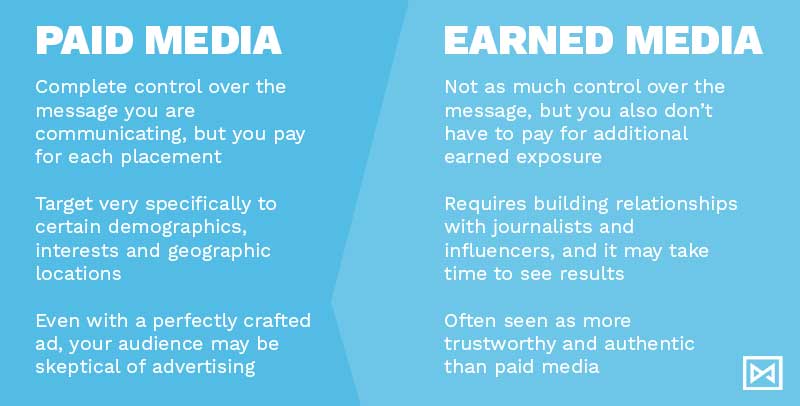The world of public relations can be a complex and ever-changing landscape, with multiple channels for brands and individuals to reach their target audience. Two of the most commonly used methods are paid media and earned media. Both have their benefits and drawbacks, and it’s important to understand the differences between them in order to make an informed decision about which one to use.
What is Paid Media?
Paid media is a form of advertising where a brand pays for space or time in a specific media channel. This can include online advertising, such as banner ads, social media ads, and Google AdWords. It can also include traditional advertising such as billboards, TV and radio ads, and print ads.
The main benefit of paid media is that it allows you to have complete control over the message you are communicating. You can create an advertisement that perfectly showcases your product or service, and you can place that advertisement in a specific media channel that your target audience is likely to see.
Another benefit of paid media is that it can often be very cost-effective. For example, online advertising can be targeted very specifically to certain demographics, interests, and geographic locations, which means you can get a lot of bang for your buck.
However, there are some downsides to paid media. One of the biggest drawbacks is that audiences are becoming increasingly wary of ads. According to a recent survey by HubSpot, only 36% of people trust ads. This means that even if you have a perfectly crafted ad, your audience may be skeptical of it.
Additionally, paid media can be expensive, particularly if you are trying to reach a large audience. This means that it may not be feasible for smaller brands or individuals with limited budgets.
What is Earned Media?
Earned media, on the other hand, is any exposure you receive from other people talking about your brand or product. This can include media coverage, social media mentions, customer reviews, and word-of-mouth recommendations.
The main benefit of earned media is that it is seen as more trustworthy and authentic than paid media. When someone else talks about your brand or product, it is seen as a third-party endorsement, which can carry a lot of weight with your audience.
Another benefit of earned media is that it can often be more cost-effective than paid media. While you may not have control over the message that is being communicated, you also don’t have to pay for the exposure.
However, there are also some downsides to earned media. One of the biggest drawbacks is that it can be difficult to control the message. If someone writes a negative review of your product, for example, it can be difficult to counteract that negative publicity.
Additionally, earned media can be more difficult to secure than paid media. It requires building relationships with journalists and influencers, and it may take time to see results.
When to Use Paid Media
Paid media is typically best used when you have a specific message that you want to communicate to a large audience. This could be the launch of a new product, a special promotion, or a major event.
Paid media is also useful when you want to reach a very specific audience. For example, if you have a niche product that is only relevant to a certain demographic, you can use online advertising to target that demographic very specifically.
Finally, paid media can be useful when you want to see quick results. Unlike earned media, which may take time to build, paid media can be launched quickly and can start generating results immediately.
When to Use Earned Media
Earned media is typically best used when you want to build trust and credibility with your audience. This is particularly important if you are a new brand or if you are entering a crowded marketplace.
Earned media is also useful when you want to generate buzz around a particular product or event. For example, if you are launching a new product or hosting a big event, you can use earned media to create excitement and anticipation among your target audience.
Finally, earned media can be useful when you want to build long-term relationships with journalists, influencers, and other key stakeholders. By building these relationships over time, you can increase the likelihood that they will talk about your brand or product in the future.
When to Use Both Paid and Earned Media
While paid and earned media are often seen as separate entities, they can also be used together to create a more effective overall strategy.
For example, you can use paid media to drive traffic to a landing page where you offer something of value, such as a free e-book or a discount code. Once people have accessed that landing page, you can use email marketing and other tactics to continue to build the relationship and encourage them to talk about your brand or product.
Another example of using paid and earned media together is through influencer marketing. You can pay influencers to promote your product on their social media channels, but you can also work to build relationships with those influencers over time so that they are more likely to mention your brand or product in the future without the need for paid promotion.
Both paid and earned media have their benefits and drawbacks, and it’s important to understand when to use each one. Paid media is best used when you have a specific message that you want to communicate to a large audience or when you want to reach a very specific demographic. Earned media, on the other hand, is best used when you want to build trust and credibility with your audience or when you want to generate buzz around a particular product or event. And while they are often seen as separate entities, paid and earned media can also be used together to create a more effective overall strategy. By understanding these differences and knowing when to use each one, you can create a comprehensive public relations strategy that effectively reaches your target audience and achieves your goals.





